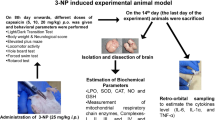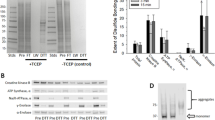Abstract
Background
Astrocytes do not only maintain homeostasis of the extracellular milieu of the neurons, but also play an active role in modulating synaptic transmission. Palmitic acid (PA) is a saturated fatty acid which, when being excessive, is a significant risk factor for lipotoxicity. Activation of astrocytes by PA has been shown to cause neuronal inflammation and demyelination. However, direct damage by PA to astrocytes is relatively unexplored. The aim of this study was to identify the mechanism(s) of PA-induced cytotoxicity in rat cortical astrocytes and possible protection by (+)-catechin.
Methods
Cytotoxicity and endoplasmic reticulum (ER) markers were assessed by MTT assay and Western blotting, respectively. Cytosolic Ca2+ and mitochondrial membrane potential (MMP) were measured microfluorimetrically using fura-2 and rhodamine 123, respectively. Intracellular reactive oxygen species (ROS) production was assayed by the indicator 2′-7′-dichlorodihydrofluorescein diacetate.
Results
Exposure of astrocytes to 100 μM PA for 24 h resulted in apoptotic cell death. Whilst PA-induced cell death appeared to be unrelated to ER stress and perturbation in cytosolic Ca2+ signaling, it was likely a result of ROS production and subsequent MMP collapse, since ascorbic acid (anti-oxidant, 100 μM) prevented PA-induced MMP collapse and cell death. Co-treatment of astrocytes with (+)-catechin (300 μM), an anti-oxidant found abundantly in green tea, significantly prevented PA-induced ROS production, MMP collapse and cell death.
Conclusion
Our results suggest that PA-induced cytotoxicity in astrocytes may involve ROS generation and MMP collapse, which can be prevented by (+)-catechin.
Similar content being viewed by others
References
Perea G, Araque A. Glial calcium signaling and neuron–glia communication. Cell Calcium 2005;38(3–4):375–82.
Verkhratsky A, Rodriguez JJ, Parpura V. Calcium signalling in astroglia. Mol Cell Endocrinol 2012;353(1–2):45–56.
Chen Y, Swanson RA. Astrocytes and brain injury. J Cereb Blood Flow Metab 2003;23:137–49.
Ransom BR, Ransom CB. Astrocytes: multitalented stars of the central nervous system. Methods Mol Biol 2012;814:3–7.
Guilherme A, Virbasius JV, Puri V, Czech MP. Adipocyte dysfunctions linking obesity to insulin resistance and type 2 diabetes. Nat Rev Mol Cell Biol 2008;9(5):367–77.
Unger RH, Scherer PE. Gluttony, sloth and the metabolic syndrome: a roadmap to lipotoxicity. Trends Endocrinol Metab 2010;21(6):345–52.
Lambertucci RH, Hirabara SM, Silveira Ldos R, Levada-Pires AC, Curi R, Pithon Curi TC. Palmitate increases superoxide production through mitochondrial electron transport chain and NADPH oxidase activity in skeletal muscle cells. J Cell Physiol 2008;216(3):796–804.
Koshkin V, Dai FF, Robson-Doucette CA, Chan CB, Wheeler MB. Limited mitochondrial permeabilization is an early manifestation of palmitate-induced lipotoxicity in pancreatic beta-cells. J Biol Chem 2008;283(12):7936–48.
Patil S, Sheng L, Masserang A, Chan C. Palmitic acid-treated astrocytes induce BACE1 upregulation and accumulation of C-terminal fragment of APP in primary cortical neurons. Neurosci Lett 2006;406(1–2):55–9.
Liu L, Martin R, Chan C. Palmitate-activated astrocytes via serine palmitoyltransferase increase BACE1 in primary neurons by sphingomyelinases. Neurobiol Aging 2013;34(2):540–50.
Gupta S, Knight AG, Keller JN, Bruce-Keller AJ. Saturated long-chain fatty acids activate inflammatory signaling in astrocytes. J Neurochem 2012;120(6):1060–71.
Wang Z, Liu D, Wang J, Liu S, Gao M, Ling EA, et al. Cytoprotective effects of melatonin on astroglial cells subjected to palmitic acid treatment in vitro. J Pineal Res 2012;52(2):253–64.
Mähler A, Mandel S, Lorenz M, Ruegg U, Wanker EE, Boschmann M, et al. Epigallocatechin-3-gallate: a useful, effective and safe clinical approach for targeted prevention and individualised treatment of neurological diseases? EPMA J 2013;4(1):5.
Mandel S, Weinreb O, Amit T, Youdim MBH. Cell signaling pathways in the neuroprotective actions of the green tea polyphenol (–)-epigallocatechin-3-gallate: implications for neurodegenerative diseases. J Neurochem 2004;88(6):1555–69.
Levites Y, Youdim MB, Maor G, Mandel S. Attenuation of 6-hydroxydopamine (6-OHDA)-induced nuclear factor-kappaB (NF-kappaB) activation and cell death by tea extracts in neuronal cultures. Biochem Pharmacol 2002;63(1):21–9.
Shah ZA, Li RC, Ahmad AS, Kensler TW, Yamamoto M, Biswal S, et al. The flavanol (–)-epicatechin prevents stroke damage through the Nrf2/HO1 pathway. J Cereb Blood Flow Metab 2010;30(12):1951–61.
Gwiazda KS, Yang TL, Lin Y, Johnson JD. Effects of palmitate on ER and cytosolic Ca2+ homeostasis in beta-cells. Am J Physiol Endocrinol Metab 2009;296(4):690–701.
Mayer CM, Belsham DD. Palmitate attenuates insulin signaling and induces endoplasmic reticulum stress and apoptosis in hypothalamic neurons: rescue of resistance and apoptosis through adenosine 5′ monophosphate-activated protein kinase activation. Endocrinology 2010;151(2):576–85.
Shoulders MD, Ryno LM, Genereux JC, Moresco JJ, Tu PG, Wu C, et al. Stressindependent activation of XBP1s and/or ATF6 reveals three functionally diverse ER proteostasis environments. Cell Rep 2013;3(4):1279–92.
Gao D, Pararasa C, Dunston CR, Bailey CJ, Griffiths HR. Palmitate promates monocyte atherogenicity via de novo ceramide synthesis. Free Radic Biol Med 2012;53(4):796–806.
Ou HC, Song TY, Yeh YC, Huang CY, Yang SF, Chiu TH, et al. EGCG protects against oxidized LDL-induced endothelial dysfunction by inhibiting LOX-1-mediated signaling. J Appl Physiol 2010;108(6):1745–56.
Chan P, Cheng JT, Tsai JC, Lien GS, Chen FC, Kao PF, et al. Effect of catechin on the activity and gene expression of superoxide dismutase in cultured rat brain astrocytes. Neurosci Lett 2002;328(3):281–4.
He Y, Cui J, Lee JC, Ding S, Chalimoniuk M, Simonyi A, et al. Prolonged exposure of cortical neurons to oligomeric amyloid-beta impairs NMDA receptor function via NADPH oxidase-mediated ROS production: protective effect of green tea (–)-epigallocatechin-3-gallate. ASN Neuro 2011;3(1):e00050.
Faria A, Pestana D, Teixeira D, Couraud PO, Romero I, Weksler B, et al. Insights into the putative catechin and epicatechin transport across blood–brain barrier. Food Funct 2011;2(1):39–44.
Wu L, Zhang QL, Zhang XY, Lv C, Li J, Yuan Y, et al. Pharmacokinetics and blood–brain barrier penetration of (+)-catechin and (−)-epicatechin in rats by microdialysis sampling coupled to high-performance liquid chromatography with chemiluminescence detection. J Agric Food Chem 2012;60(37):9377–83.
Author information
Authors and Affiliations
Corresponding authors
Rights and permissions
About this article
Cite this article
Wong, KL., Wu, YR., Cheng, KS. et al. Palmitic acid-induced lipotoxicity and protection by (+)-catechin in rat cortical astrocytes. Pharmacol. Rep 66, 1106–1113 (2014). https://doi.org/10.1016/j.pharep.2014.07.009
Received:
Revised:
Accepted:
Published:
Issue Date:
DOI: https://doi.org/10.1016/j.pharep.2014.07.009




